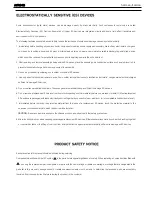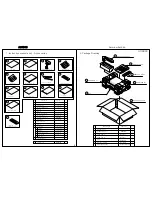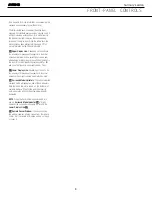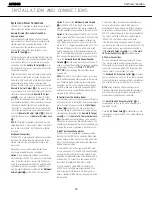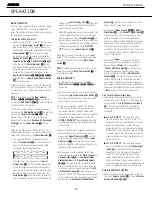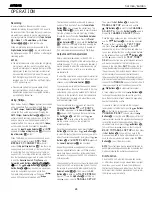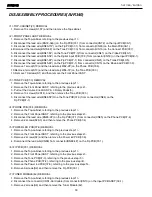
INSTALLATION AND CONNECTIONS
System Installation
After unpacking the unit, locating it in a place with ade-
quate ventilation and placing it on a solid surface capable
of supporting its weight, you will need to make the con-
nections to your audio and video equipment.
IMPORTANT NOTE:
For your personal safety and to
avoid possible damage to your equipment and speakers,
it is always a good practice to turn off and unplug the
AVR and ALL source equipment from the AC output
before making any audio or video system connections.
Audio Equipment Connections
We recommend that you use high-quality interconnect
cables when making connections to source equipment
and recorders to preserve the integrity of the signals.
1. Connect the analog outputs of a CD player to the
CD Audio Inputs
£
.
NOTE:
When the CD player has both fixed and vari-
able audio outputs, it is best to use the fixed output
unless you find that the input to the receiver is so
low that the sound is noisy, or so high that it is
distorted.
2. Connect the analog Play/Out jacks of a cassette
deck, MD, CD-R or other audio recorder to the
Tape Input Jacks
f
. Connect the analog
Record/In jacks on the recorder to the
Tape
Output Jacks
g
on the AVR 340.
3. Connect the output of any digital sources such as
a CD or DVD changer or player, advanced video
game, a digital satellite receiver, HDTV tuner or
digital cable set-top box or the output of a com-
patible computer sound card to the
Optical
and
Coaxial Digital Audio Inputs
fif
*(
. We
recommend connecting the coaxial digital audio
output of your DVD player to the
Coax 1 Digital
Audio Input
f
, since that digital input is
assigned to the DVD source by default. The Video
2/Cable/Sat source defaults to the
Optical 1
Digital Audio Input
fi
. If your cable television
set-top box or satellite receiver is equipped with
an optical digital audio output, we recommend that
you connect it to this input to obtain the benefits
of higher-quality digital audio (such as PCM, Dolby
Digital 2.0 or Dolby Digital 5.1 signals when broad-
cast by your cable or satellite provider).
NOTE:
If you wish for your digital source device to
be available for use by the multiroom system, you will
need to connect its analog audio outputs to the appro-
priate inputs on the AVR 340, as the multiroom sys-
tem is not capable of distributing digital signals to the
remote zone.
4. Connect the
Coaxial
or
Optical Digital Audio
Outputs
de
on the rear panel of the AVR 340 to
the matching digital input connections on a CD-R or
MiniDisc or other digital recorder.
5. Assemble the AM Loop Antenna supplied with the
unit so that the tabs at the bottom of the antenna
loop snap into the holes in the base. Connect it to
the
AM Antenna Terminals
h
.
6. Connect the supplied FM antenna to the
FM
(75-
ohm)
Connection
¡
. The FM antenna may be an
external roof antenna, an inside powered or wire-
lead antenna or a connection from a cable TV sys-
tem. If the antenna or connection uses 300-ohm
twin-lead cable, you must use an optional 300-
ohm-to-75-ohm adaptor to make the connection.
7. With the AVR 340 turned off, connect the optional
Harman Kardon
to
Digital Media
Player (DMP) Connector
j
. Your compatible
iPod may be docked in
when you wish to
use it as an audio source device. Video materials
stored on the iPod may not be viewed through
The Bridge.
8. Connect the front, center, surround and surround
back speaker outputs
⁄¤‹›
to the respec-
tive speakers.
To ensure that all the audio signals are carried to your
speakers without loss of clarity or resolution, we sug-
gest that you use high-quality speaker cable. Many
brands of cable are available and the choice of cable
may be influenced by the distance between your
speakers and the receiver, the type of speakers you
use, personal preferences and other factors. Your dealer
or installer is a valuable resource to consult in select-
ing the proper cable.
Regardless of the brand of cable selected, we recom-
mend that you use a cable constructed of multistrand
copper with a gauge of 14 or smaller. Remember that
in specifying cable, the lower the number, the thicker
the cable.
Cable with a gauge of 16 may be used for short runs
of less than 10 feet. We do not recommend that you
use cables with an AWG equivalent of 18 or higher,
due to the power loss and degradation in performance
that will occur.
Cables that are run inside walls should have the appro-
priate markings to indicate listing with UL, CSA or other
appropriate testing agency standards. Questions about
running cables inside walls should be referred to your
installer or a licensed electrician who is familiar with
the NEC and/or the applicable local building codes in
your area.
When connecting wires to the speakers, observe
proper polarity. Note that the positive (+) terminal of
each speaker connection may carry a specific color
code, as noted on page 8. However, many speakers
still use a red terminal for the positive (+) connection.
Connect the “negative” or “black” wire to the same ter-
minal on both the receiver and the speaker.
NOTE:
While most speaker manufacturers adhere to
an industry convention of using black terminals for
negative and red ones for positive, some may vary
from this configuration. To ensure proper phase and
optimal performance, consult the identification plate on
your speaker or the speaker’s manual to verify polarity.
If you do not know the polarity of your speaker, ask
your dealer for advice before proceeding, or consult
the speaker’s manufacturer.
We also recommend that the length of cable used
to connect speaker pairs be identical. For example,
use the same length piece of cable to connect the
front-left and front-right or surround-left and sur-
round-right speakers, even if the speakers are a
different distance from the AVR 340.
9. Connections to a subwoofer are normally made
via a line-level audio connection from the
Subwoofer Output
•
to the line-level input of a
subwoofer with a built-in amplifier. When a passive
subwoofer is used, the connection first goes to a
power amplifier, which will be connected to one
or more subwoofers. If you are using a powered
subwoofer that does not have line-level input con-
nections, follow the instructions furnished with the
speaker for connection information.
10. If an external multichannel audio source with 5.1,
6.1 or 7.1 outputs such as an external digital
processor/decoder, DVD-Audio or SACD player
is used, connect the outputs of that device to
the
6/8-Channel Direct Inputs
X
.
Video Equipment Connections
Video equipment is connected in the same manner as
audio components. The use of high-quality interconnect
cables is recommended to preserve signal quality.
1. Connect a VCR’s, DVD recorder’s, personal video
recorder’s or other video source’s audio and video
Play/Out jacks to the
Video 1 Audio
/
Video
and/or
S-Video Input Jacks
Ra
on the rear panel. The
Audio and Video Record/In jacks on the recorder
should be connected to the
Video 1 Audio/Video
and/or
S-Video Output Jacks
Tb
on the AVR 340.
Although any video device may be connected to
these jacks, we recommend connecting your video
The
Bridge
TM
The
Bridge
TM
The
Bridge
TM
16
INSTALLATION AND CONNECTIONS
INSTALLATION AND CONNECTIONS
AVR 340 OM 9/13/05 12:45 PM Page 16
AVR340
harman/kardon
16
Summary of Contents for AVR 340
Page 33: ...AVR340 harman kardon 33...
Page 35: ...AVR340 harman kardon 35...
Page 80: ...AVR340 harman kardon...
Page 81: ...AVR340 harman kardon...
Page 82: ...AVR340 harman kardon 82...
Page 83: ...CAM350 PRO V 7 6 Mon Sep 01 10 29 56 2003 Untitled AVR340 harman kardon 83...
Page 84: ...AVR340 harman kardon 84...
Page 85: ...AVR340 harman kardon 85...
Page 123: ...AVR340 harman kardon 123...
Page 124: ...AVR340 harman kardon 124...
Page 125: ...AVR340 harman kardon 125...
Page 126: ...AVR340 harman kardon 126...
Page 129: ...AVR340 harman kardon 129...
Page 130: ...AVR340 harman kardon 130...
Page 131: ...AVR340 harman kardon 131...
Page 132: ...AVR340 harman kardon 132...
Page 133: ...AVR340 harman kardon 133...
Page 134: ...AVR340 harman kardon 134...
Page 135: ...AVR340 harman kardon 135...
Page 136: ...AVR340 harman kardon 136...
Page 137: ...AVR340 harman kardon 137...
Page 139: ...TC90A49P F BLOCK DIAGRAM PIN ASSIGNMENT AVR340 harman kardon 139...
Page 148: ...AVR340 harman kardon 148...
Page 151: ...LC74763M BLOCK DIAGRAM AVR340 harman kardon 151...
Page 158: ...AVR340 harman kardon 158...
Page 159: ...AVR340 harman kardon 159...
Page 162: ...AVR340 harman kardon 162...
Page 166: ...AVR340 harman kardon 166...
Page 167: ...AVR340 harman kardon 167...
Page 168: ...AVR340 harman kardon 168...
Page 169: ...AVR340 harman kardon 169...
Page 170: ...AVR340 harman kardon 170...
Page 171: ...AVR340 harman kardon 171...
Page 172: ...AVR340 harman kardon 172...
Page 173: ...AVR340 harman kardon 173...
Page 176: ...AVR340 harman kardon 176...
Page 178: ...AVR340 harman kardon 178...
Page 179: ...SCHEMATIC sch 1 Fri Oct 21 10 53 55 2005 AVR340 harman kardon 179...
Page 180: ...LPP 051021 sch 1 Fri Oct 21 10 40 28 2005 AVR340 harman kardon 180...
Page 181: ...NPUT LPP 051021 sch 2 Fri Oct 21 10 42 09 2005 AVR340 harman kardon 181...
Page 182: ...UT LPP 051021 sch 3 Fri Oct 21 10 43 03 2005 AVR340 harman kardon 182...
Page 183: ...EMATIC sch 1 Fri Oct 21 10 52 43 2005 AVR340 harman kardon 183...
Page 184: ...CHEMATIC sch 1 Fri Oct 21 10 56 51 2005 AVR340 harman kardon 184...
Page 185: ...SCHEMATIC sch 2 Thu Oct 27 15 39 31 2005 AVR340 harman kardon 185...
Page 186: ..._0810 sch 1 Wed Aug 10 16 28 25 2005 AVR340 harman kardon 186...

